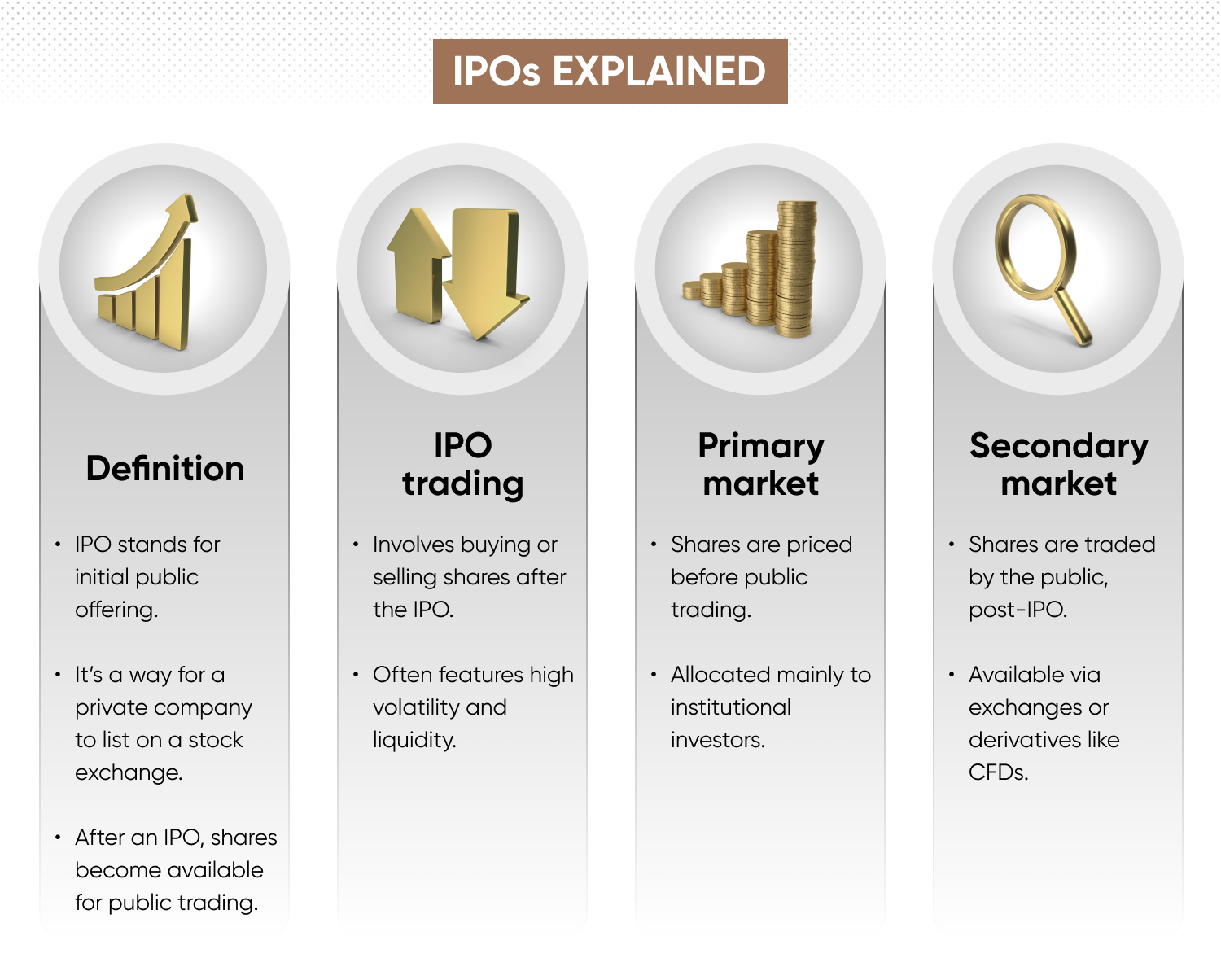What is an IPO and how does it work?

IPOs are key market events for shares traders as they introduce a new asset to the financial marketplace. Learn all about what they are, why companies go public, and the processes involved in listing a company.
What is an IPO?
IPO trading refers to buying and selling, or speculating on, shares in a company after it goes public through an initial public offering (IPO). In most cases, a private company will list on a stock exchange following its IPO, making its shares available for public trading for the first time.
In the primary market, IPO shares are priced and allocated to institutional investors before public trading begins. Once listed, the shares become available in the secondary market, where they are bought and sold – or speculated on using financial derivatives such as CFDs.
Traders could aim to capture gains on short-term price movements, as liquidity and volatility may be elevated in the initial days of trading, once the company’s shares are publicly listed and actively traded.
Learn more about Klarna's upcoming IPO.

Why do companies go public?
- Access to capital
Listing on a stock exchange and selling shares provides companies with access to significant amounts of capital. Such funds are often used for expansion, research and development, acquisitions, debt repayment, and working capital. - Liquidity for traders/investors
Going public provides liquidity for existing shareholders, including founders, early investors, and employees who hold equity in the company. Publicly traded shares can be bought and sold on stock exchanges, providing investors and traders with an exit strategy and the ability to realise their investment. - Marketing
A public listing can increase a company's visibility and credibility in the market. Being publicly traded can attract attention from customers, suppliers, and potential business partners. It can also enhance the company's brand image and reputation. - Currency for acquisitions
Publicly traded shares can be used as currency for acquisitions. Companies can use their stock to acquire other businesses, providing an alternative to cash transactions and enabling them to pursue growth through strategic acquisitions. - Employee incentives
Publicly traded companies can offer stock-based compensation, such as stock options and restricted stock units, to attract and retain talented employees. Equity incentives can align the interests of employees with those of shareholders and provide employees with a stake in the company's success. - Valuation and benchmarking
Going public can provide a transparent market valuation for the company. Publicly traded companies are subject to market scrutiny and are valued based on their performance and prospects. This valuation can be used for benchmarking purposes and can help attract investors and strategic partners. - Exit strategy for investors
For venture capitalists, private equity firms, and other early investors, an IPO provides an exit strategy, allowing them to monetise their investment and realise a return on their capital. Going public provides potential trading opportunities for these investors to sell their shares to the public or institutional investors.
What is the IPO process?
The IPO process comprises a range of steps, from due diligence and registration to pricing and closing and beyond. Here are the key stages a company is likely to go through on the road to listing its shares.
- Preparation
Before the IPO, the company selects underwriters to manage the process, prepares financial statements, drafts regulatory filings, and establishes a timeline for the offering. This phase involves comprehensive planning to ensure a smooth transition to public company status. - Due diligence
The company and its underwriters conduct thorough due diligence to assess compliance with regulatory requirements and to evaluate the company's financial performance, business operations, and potential risks. This step is critical for identifying any issues that need to be addressed before proceeding with the IPO. - Registration
The company files a registration statement with the relevant securities regulator, such as the FCA. This document provides detailed information about the company, its business, financials, management team, and the proposed offering. It serves as the basis for regulatory review and investor disclosure. - Roadshow
There may be a roadshow where the company and its underwriters market the IPO to potential investors. Company executives and underwriters meet with institutional investors, analysts, and other stakeholders to present the investment opportunity, discuss the company's prospects, and address any questions or concerns. - Pricing
Based on feedback from the roadshow and market conditions, the underwriters determine the final offering price and the number of shares to be sold. This step is crucial as it determines the valuation of the company and the amount of capital it will raise through the IPO. - Regulatory review
A regulatory agency such as the SEC in the US, or the FCA in the UK, reviews the registration statement and may issue comments or requests for clarification. The company and its underwriters work to address any concerns raised by the body to ensure compliance with securities laws and regulatory requirements. - Closing
On the day of the IPO, the company and its underwriters finalise the offering. Shares are priced and allocated to investors, and the company's shares begin trading on the stock exchange. The offering proceeds are transferred to the company, marking its transition to public company status. - Post-IPO
After the IPO, the company becomes a publicly traded company and must comply with ongoing reporting and disclosure requirements. It communicates with shareholders, manages its public image and reputation, and navigates the challenges and opportunities of being a publicly traded company.
How can I trade an IPO?
When an IPO has launched, you can either buy the physical shares or trade them using a derivative such as a CFD. Buying the physical shares through a traditional stockbroker, or via an online platform, means you’re hoping for the shares to increase in value, while trading the derivative means you can employ leverage to take a position on the price either increasing or decreasing. CFDs are typically traded on margin, which means that you can gain exposure to larger positions with a relatively small outlay. This amplifies your potential profits but also your potential losses, making leveraged trading risky.
Explore how risk management plays an important role in trading.
Learn more about Stripe IPO in our comprehensive guide.

What are the risks and benefits of an IPO?
Potential benefits
-
Early access to newly listed companies: IPOs can provide access to emerging stocks, including those in high-growth sectors like fintech and AI, with potential for early momentum gains.
-
Potential for price swings: IPO stocks can experience substantial price fluctuations, presenting potential opportunities for short-term traders – although the possibility of reversals poses a risk.
-
Expanded trading opportunities: New listings may introduce companies from less-represented industries to the stock market, broadening trading options.
Potential risks
-
Market uncertainty: IPO performance is influenced by broader economic conditions, interest rates, and sentiment.
-
Potential overvaluation: High initial demand can inflate prices, leading to sharp corrections if expectations aren’t met.
-
Variable liquidity: Some IPOs face liquidity constraints that can cause price gaps and execution challenges, while others attract significant market interest.
FAQs
How much does an IPO cost?
IPO costs for companies planning to list can vary significantly based on the size and complexity of the offering, as well as the region and perceived risks. The fees involved in going public include underwriting, legal and accounting, marketing, listing, and regulatory costs, most of which are unavoidable. Accordingly, the fee can range from hundreds of thousands of pounds to several million for more complex deals.
How long is the IPO process?
The duration of the IPO process can vary according to the complexity of the deal and how long is spent on each of the constituent processes. For example, the preparation stage, involving an internal assessment, the selection of advisers, and preparing the registration statement, can be the most involved and challenging part of the listing, potentially taking more than a year. Subsequent stages such as marketing and closing are likely to be less time-consuming due to the preparation having already been done.
How do you find IPO companies?
To find IPO companies, it’s advisable to stay up to date with the latest financial news using trusted sources. Sometimes, specialist sites may have information on upcoming IPOs sooner than larger outlets. Other potential resources include regulatory body filings, investment bank media centres, social media and forums, and professional networks such as venture capitalist and corporate adviser circles, all of which can provide information from relevant parties on listing prospects.